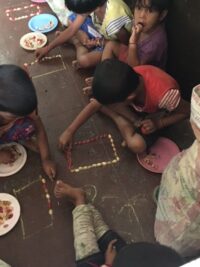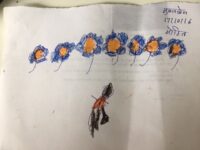
Watching Avinash creating a beautiful Rangoli pattern for Diwali made me think about how carefully and finely he was using his hands and fingers to place the sand in such intricate shapes, spaces and patterns. He placed a scoop of sand in the middle of his palm and then made a fist which acted as a funnel to carefully pour the sand out in fine lines. He used his fingers to mark out the shapes and create the clear lines of the pattern.
It made me think about the young children I had watched at the Door Step Anganwadi in Mumbai and how impressive they were in using their fine motor skills to create patterns and draw small, detailed pictures with their pens and crayons. These children were 3 and 4 years old..sitting on the floor in a very small space with about 14 other children.
 In one room children were busy using small coloured pistachio shells to make a frame around a rectangle which had been chalked on the concrete floor by the adult. Their concentration and hand eye co-ordination was impressive as well as their ideas about pattern making and sequencing (all mathematical skills) - we watched them as they busily got on with the task in hand.
In one room children were busy using small coloured pistachio shells to make a frame around a rectangle which had been chalked on the concrete floor by the adult. Their concentration and hand eye co-ordination was impressive as well as their ideas about pattern making and sequencing (all mathematical skills) - we watched them as they busily got on with the task in hand.
In the next small room the children were drawing flowers ( a theme they were following on flowers and growth). The careful, precise and detailed drawings were happening all around - we could see the way that they manipulated their pens (boys and girls) with confidence and without any pressure to draw or write..they were engaged, involved and enjoying the task taking great delight in showing what they had done to the teacher. The teachers then talk about the 'ideas the children have drawn and write down their story'.
Hands and fingers are an important part of expression in India - we noticed this a lot as we saw people talking, cooking, dancing and making Rangoli patterns. The ancient practice of mhendi patterns on hands and feet (arms, legs) also shows the fine patterns that are everywhere in India. Fine beautiful paintings on the walls in Temples, palaces and old houses were another sign of delicate pictures and patterns though we were not allowed to photograph them 🙁
These are all an implicit part of children's culture and heritage which they seem to tune into naturally...its like an organic growth of their fine motor and hand-eye co-ordination without any pressure or formality to write. The origins being firmly in abstract pattern making and drawing rather than letter formation and the dreaded handwriting that our children are having to endure at even younger ages.
Maybe we need to take some note of this and think about more creative and organic ways we can support young children to become artists like Avinash?